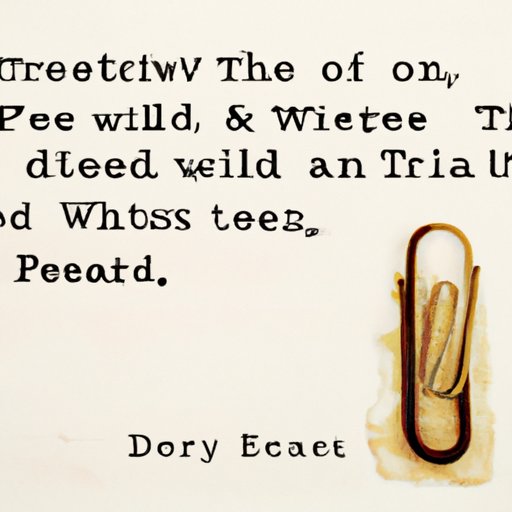
Introduction
Poetry has gone through countless transformations over the centuries, evolving from structured rhymes to a more diverse range of styles and expression of emotions and ideas. One such style is free verse poetry, a form that has gained immense popularity in recent times. But what is free verse poetry, how does it differ from traditional poetry, what are its benefits and limitations, and how do you get started with writing it? This article aims to answer all these questions and more, helping people understand and appreciate the beauty of free verse poetry.
Definition-based
Free verse poetry is a form of poetry that does not follow any predefined structure or rhyme scheme. Unlike traditional poetry, which typically follows a specific meter or pattern of stressed and unstressed syllables, free verse poetry gives the poet complete freedom to write in whichever way they deem fit, following the flow of their emotions and thoughts.
Free verse poetry has its roots in the 19th century when poets such as Walt Whitman and Emily Dickinson began experimenting with a looser, less formal style of writing. However, it wasn’t until the early 20th century that the term “free verse” was coined, and the style gained widespread recognition.
Examples-based
Some of the most popular free verse poems include “The Waste Land” by T.S. Eliot, “Song of Myself” by Walt Whitman, and “Howl” by Allen Ginsberg. These poems typically do not follow any specific rhyme or meter but often have a distinctive rhythm that makes them easy to read and understand.
Free verse poetry is known for its ability to convey complex emotions and themes, such as love, loss, freedom, and identity. It often employs the use of vivid imagery, metaphor, and symbolism to create a powerful impact on the reader.
Advantages and Disadvantages
One of the main advantages of writing in free verse poetry is the freedom it provides the poet. With no set rules, the poet can express themselves in any way they want, making the poem more personal and authentic. Free verse poetry also allows for a more natural and conversational tone, making it easier for readers to relate to the poem.
However, free verse poetry also has its limitations. Without any predefined structure, it can be challenging to maintain coherence and structure, leading to a disjointed or scattered poem. It can also be difficult to know when a free verse poem is complete or whether it needs more refinement and editing.
Comparisons
Free verse poetry differs from other poetic styles such as sonnets, haikus, or ballads, whereby these styles usually have a specific rhyme scheme, meter, or structure. While they have their own unique advantages and limitations, free verse poetry allows for complete creativity and self-expression, giving the poet the freedom to write what they feel and how they feel it.
Writing your first free verse poem
If you are new to free verse poetry, then getting started can be a little daunting. Here is a beginner’s guide to writing your first free verse poem:
- Start with a topic: Choose a subject that you feel inspired or passionate about. This could be anything from love, nature, or nostalgia.
- Brainstorm: Jot down any ideas that come to mind when thinking of your topic. Don’t worry about making sense or structure at this point.
- Organize your ideas: Once you have a few different ideas, start to think about how they could come together. Look for threads and connections, grouping ideas that are similar or complement each other.
- Write: Now it’s time to start writing. Don’t worry about structure, rhyme, or meter; instead, focus on getting your ideas down onto paper and conveying the emotions or thoughts you want to express.
- Refine and edit: Once you have your poem down, take some time to read it through and make any necessary changes. Cut out any cliches or unnecessary phrases, and hone in on the message you want to convey. Rearrange lines for flow and cohesion.
- Share: Finally, share your poem with someone you trust. Get feedback, ask for advice, and be open to constructive criticism. Remember, even the most renowned poets refine and edit their work multiple times before publishing it.
Analyzing popular free verse poems
“The Waste Land” by T.S. Eliot and “Song of Myself” by Walt Whitman are two of the most popular free verse poems ever written. These poems employ various literary devices and techniques that make them stand out in the world of poetry.
“The Waste Land” is known for its use of fragmentation, jumping from one scene, character, or image to another, creating a sense of disillusion and disorientation that reflects the cultural climate of the time. The poem also utilizes imagery and symbolism to convey themes of death, rebirth, and the search for spiritual renewal.
“Song of Myself” is a poem that celebrates the self and the diversity of life, exploring the relationship between man and nature. Whitman utilized long lines and a catalog form of enumeration and description to create a sense of oneness and unity, conveying the idea that all things are interconnected.
Conclusion
In conclusion, free verse poetry is a unique and expressive style of writing that has gone through significant transformations over the centuries. From its roots in the 19th century to its widespread recognition in the 20th century, free verse poetry has emerged as a popular and prevalent style of poetry, offering poets the freedom to express themselves in their own unique way.
While free verse poetry has its advantages and limitations, it allows for complete creativity and self-expression, making it a great way to convey complex emotions and themes. By writing your own free verse poem, you can experience firsthand the benefits of this style and analyze other renowned poets to discover what makes their work so engaging and powerful.





